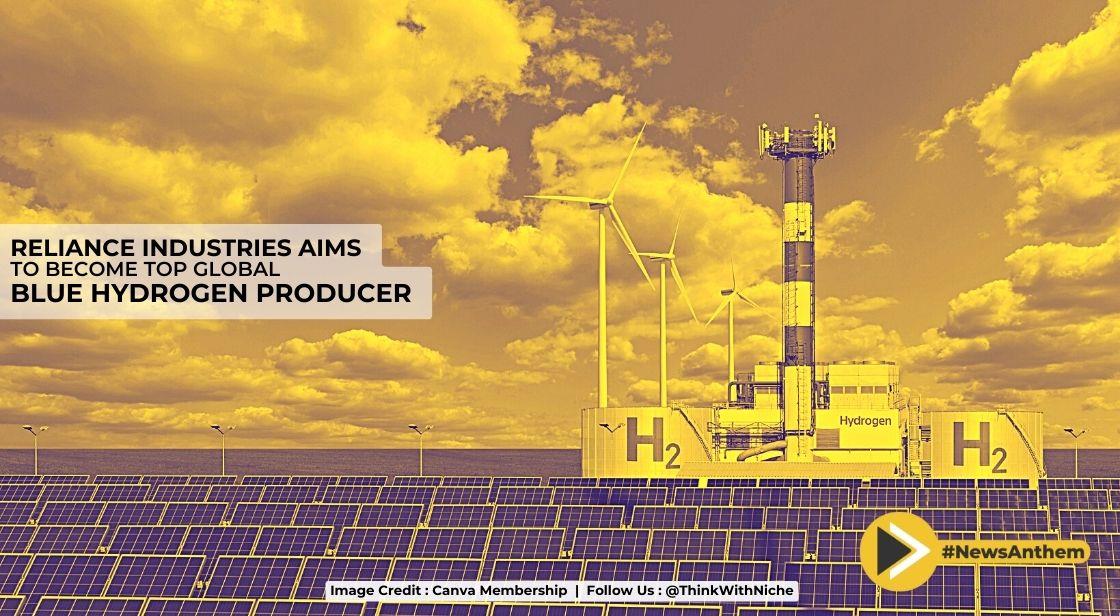Reliance Industries Aims To Become Top Global Blue Hydrogen Producer

News Synopsis
Reliance Industries, owned by billionaire Mukesh Ambani, plans to become one of the largest producers of blue hydrogen worldwide. The company aims to produce zero-emission fuel at costs that are half of the global average. The company plans to re-purpose an existing plant to produce blue hydrogen for $1.2-1.5 a kilogram. The move towards blue hydrogen is part of Reliance's plan to reduce carbon emissions and transition from fossil fuels to renewable energy sources. The company aims to produce green hydrogen at $1 per kilogram by the end of the decade. The repurposed gasification unit will also provide a unique opportunity to capture 15 million tonnes per annum of CO2 at a low cost.
Reliance Industries, one of India's largest conglomerates, has set its sights on becoming one of the largest global producers of blue hydrogen. Blue hydrogen is generated from natural gas, but the carbon produced from the process is captured and stored, making it carbon neutral. Reliance Industries plans to produce the zero-emission fuel at a cost that is half the global average.
The company will re-purpose a plant that currently converts petroleum coke into synthesis gas to produce blue hydrogen for $1.2-1.5 a kilogram. The plant is part of the world's largest oil refining complex, located in Jamnagar in Gujarat. Reliance Industries plans to transfer the syngas project to a subsidiary, unlocking value in the process. The company is looking to transition from fossil fuels to renewable energy sources and maximize sustainable materials and chemicals in its portfolio.
Reliance Industries has set a net-zero carbon emission target for its businesses by 2035. The company is looking at blue hydrogen in the interim period to reduce the cost of green hydrogen. Green hydrogen is produced using clean energy from renewable sources, such as solar or wind power, and costs between $3-6.55 per kg. The European Commission estimated the cost of blue hydrogen at about $2.40-3 per kg. Fossil-based hydrogen costs about $1.80 per kg.
Ambani had previously stated that his group is aiming to produce green hydrogen at $1 per kilogram by the turn of this decade. Last month, he announced plans to invest about $75 billion in renewables infrastructure. The company's framework for reducing its carbon footprint includes carbon fixation, capture, and utilization, migration from fossil energy to renewables, and maximizing sustainable materials and chemicals.
The repurposing of the gasification assets will involve using syngas to produce hydrogen. Over time, hydrogen demand will be met by green hydrogen produced through water electrolysis. The entire syngas will be converted to chemicals as hydrogen from syngas is replaced by green hydrogen. The company plans to explore biomass feed in gasification to produce green hydrogen.
The gasification unit is proposed to be transferred as a going concern on a slump sale basis. The proposed scheme has been presented to the National Company Law Tribunal for approval. The gasification unit is currently used to produce syngas from low-value fuel streams, which are taken out from the fuel pool and used as feedstock to convert to high-value petrochemicals.
Reliance Industries said that fossil fuel could be replaced by renewables, including solar, biomass-based fuel, hydrogen, and changing steam drives to electric drives. Jamnagar will progressively transition to renewables with a battery energy storage system (BESS) to meet its electricity and steam demand. The company plans to monetize the highly concentrated carbon dioxide (CO2) stream produced by hydrogen production from gasification by selling it to urea producers and other users. Reliance said this CO2 can be captured at 30% of the typical cost of carbon capture.
Reliance Industries aims to establish a hydrogen ecosystem in India, with minimal incremental investment, while the cost of green hydrogen comes down. The company said that the syngas has the potential to produce hydrogen at a competitive cost of $1.2-1.5 per kg. Reliance Industries' move towards blue hydrogen is part of a wider trend among energy companies to reduce their carbon footprint and transition towards renewable energy sources.
In conclusion, Reliance Industries plan to become one of the largest global producers of blue hydrogen is an ambitious one. The company is looking to reduce its carbon footprint and transition from fossil fuels to renewable energy sources. Blue hydrogen is a cleaner alternative to grey hydrogen, which is generated from natural gas. Reliance Industries plans to use syngas to produce hydrogen and explore biomass feed.
You May Like









